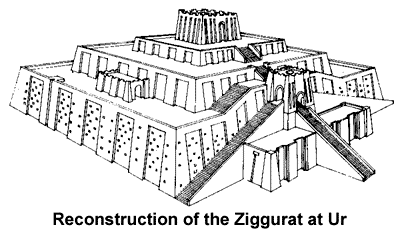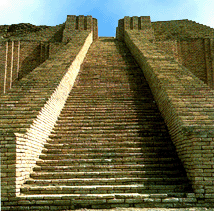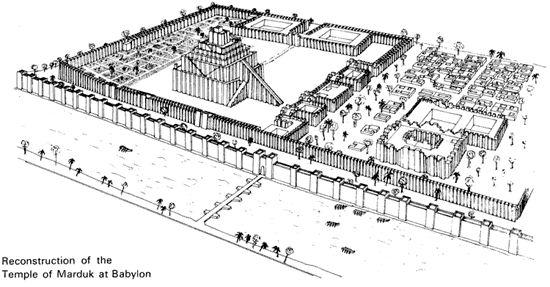Ancient Babylonia - The Ziggurats


One of the most important aspects of Babylonian religion and tradition, and probably the best known, is the ziggurat.
Ziggurats were huge "stepped" structures with, on their summit, far above the ground, a temple. This Temple would have been to the city god. The city ziggurat would easily be the most conspicuous building in the city, towering above any visitors coming to their city. Therefore the ziggurat was not just a religious center but also a center of civic pride. Any visitor could not but see the ziggurat. The ziggurats were built on an immense scale: in the time of Hammurapi they would sometimes reach the height of 150 feet. Around the base there might be more temples or in some case accommodation for priests.
 Some of the earliest proper ziggurats were built by Ur-Nammu (2112-2095), a
late Sumerian king of Ur. These were with three "steps" but later Ziggurats had
as many as seven "steps".
Some of the earliest proper ziggurats were built by Ur-Nammu (2112-2095), a
late Sumerian king of Ur. These were with three "steps" but later Ziggurats had
as many as seven "steps".
Similar structures to ziggurats have been discovered at the other side of the world, in Central America. The Aztecs and other people inhabiting the area built huge "stepped" structures for worshipping their gods. These however were some 3000 years after the early Mesopotamian ziggurats. What part did Ziggurats play in Religion? Ziggurats were built to reach nearer the heavens. This was so the gods could be contacted and worshipped. Obviously the same can be done on ground level but on top of the ziggurat they would be "nearer the god".
The Babylonians, and others of their religion, gave rich offerings to the gods and built splendid temples. Similarly they built ziggurats. The size and splendor of a ziggurat would show the city and king�s devotion to the particular city god being worshipped. They might have temples to other gods but they would only have a ziggurat to the city god.

The Building of the Tower of Babel,
by Abel Grimmer (1570-1619) The Tower of Babel Of the ziggurat built in Babylon at the time of Hammurapi we know little but there is a large amount of documentation of the ziggurat that existed in the time of Nebuchadnezzar II (605-562 BC) who deported the Jews.
This was a ziggurat already old by the time of his reign and could have been the same as the ziggurat that existed in the reign of Hammurapi. Its Babylonian name was "Etemenanki" (see below) which means in English "House of the platform of Heaven and Earth". This temple is often associated with the famous Tower of Babel which men built to rival God. Indeed so it must have seemed to an Israelite observer whose cities were often no more than the size of our villages. They would be confronted first with the size of the city, which encompassed, at that time, both sides of the Euphrates. Babylon in the time of Nebuchadnezzar II was large even by our standards. In the city they would see the ziggurat, which would seem to them, usually living in single story houses, to reach almost to heaven. Many Jews would have seen it with their own eyes when they were deported to Babylon in about 600 BC. This would have no doubt reminded them of the events at the Tower of Babel.
The Bible reveals very little about the ziggurat. There are other sources outside of the Bible that reveal what a Ziggurat is. We have a Babylonian tablet that gives us the dimensions of the ziggurat at the time of Nebuchadnezzar II. The ziggurat�s condition declined and it was in ruins when Alexander arrived in 331 BC.

The restored remains of the great ziggurat
of ancient Ur, in southern Iraq. It was built
with similar characteristics as the Tower of
Babel mention in the Bible (see Gen 10). Etemenanki (House of the platform of Heaven and Earth)
Thanks to a tablet that has been found we are in the possession of most of the dimensions of the ziggurat:
- st step 300ft by 300ft 110ft high
2nd step 260ft by 260ft 60ft high
3rd step 200ft by 200ft 20ft high
4th step 170ft by 170ft 20ft high
5th step 140ft by 140ft 20ft high
6th step ? 20ft high?
7th step 70ft by 80ft 50ft high
This means that the temple situated on the very top of the ziggurat was three hundred feet high.
The main structure of the ziggurat was trodden clay but there was a layer of bricks on the outside. The top of the ziggurat was reached by a broad stairway going up the side. This stairway was said to be thirty feet wide. Around the base of the ziggurat was a line of buildings. These were storerooms, accommodation for priests and others connected with the temple.

Babylon in the time of Nebuchadnezzar II.
At its heart was Esagila, a huge sanctuary
complex which contained the temple of Marduk,
and E-Temen-an-ki, the great ziggurat of Babylon,
probably the prototype of the Tower of Babel.

Read The Bible
- 1599 Geneva Bible (GNV)
- 21st Century King James Version (KJ21)
- American Standard Version (ASV)
- Amplified Bible (AMP)
- Amplified Bible, Classic Edition (AMPC)
- Authorized (King James) Version (AKJV)
- BRG Bible (BRG)
- Christian Standard Bible (CSB)
- Common English Bible (CEB)
- Complete Jewish Bible (CJB)
- Contemporary English Version (CEV)
- Darby Translation (DARBY)
- Disciples’ Literal New Testament (DLNT)
- Douay-Rheims 1899 American Edition (DRA)
- Easy-to-Read Version (ERV)
- English Standard Version (ESV)
- English Standard Version Anglicised (ESVUK)
- Evangelical Heritage Version (EHV)
- Expanded Bible (EXB)
- GOD’S WORD Translation (GW)
- Good News Translation (GNT)
- Holman Christian Standard Bible (HCSB)
- International Children’s Bible (ICB)
- International Standard Version (ISV)
- J.B. Phillips New Testament (PHILLIPS)
- Jubilee Bible 2000 (JUB)
- King James Version (KJV)
- Lexham English Bible (LEB)
- Living Bible (TLB)
- Modern English Version (MEV)
- Mounce Reverse Interlinear New Testament (MOUNCE)
- Names of God Bible (NOG)
- New American Bible (Revised Edition) (NABRE)
- New American Standard Bible (NASB)
- New American Standard Bible 1995 (NASB1995)
- New Catholic Bible (NCB)
- New Century Version (NCV)
- New English Translation (NET)
- New International Reader's Version (NIRV)
- New International Version - UK (NIVUK)
- New International Version (NIV)
- New King James Version (NKJV)
- New Life Version (NLV)
- New Living Translation (NLT)
- New Matthew Bible (NMB)
- New Revised Standard Version (NRSV)
- New Revised Standard Version Catholic Edition (NRSVCE)
- New Revised Standard Version, Anglicised (NRSVA)
- New Revised Standard Version, Anglicised Catholic Edition (NRSVACE)
- New Testament for Everyone (NTE)
- Orthodox Jewish Bible (OJB)
- Revised Geneva Translation (RGT)
- Revised Standard Version (RSV)
- Revised Standard Version Catholic Edition (RSVCE)
- The Message (MSG)
- The Voice (VOICE)
- Tree of Life Version (TLV)
- World English Bible (WEB)
- Worldwide English (New Testament) (WE)
- Wycliffe Bible (WYC)
- Young's Literal Translation (YLT)
Table of Contents
Main Menu
- Ancient Assyrian Social Structure
- Ancient Babylonia
- Ancient Canaan During the Time of Joshua
- Ancient History Timeline
- Ancient Oil Lamps
- Antonia Fortress
- Archaeology of Ancient Assyria
- Assyria and Bible Prophecy
- Augustus Caesar
- Background Bible Study
- Bible
- Biblical Geography
- Fallen Empires - Archaeological Discoveries and the Bible
- First Century Jerusalem
- Glossary of Latin Words
- Herod Agrippa I
- Herod Antipas
- Herod the Great
- Herod's Temple
- High Priest's in New Testament Times
- Jewish Literature in New Testament Times
- Library collection
- Map of David's Kingdom
- Map of the Divided Kingdom - Israel and Judah
- Map of the Ministry of Jesus
- Matthew Henry Bible Commentary
- Messianic Prophecy
- Nero Caesar Emperor
- Online Bible Maps
- Paul's First Missionary Journey
- Paul's Second Missionary Journey
- Paul's Third Missionary Journey
- Pontius Pilate
- Questions About the Ancient World
- Tabernacle of Ancient Israel
- Tax Collectors in New Testament Times
- The Babylonian Captivity
- The Black Obelisk of Shalmaneser
- The Books of the New Testament
- The Court of the Gentiles
- The Court of the Women in the Temple
- The Destruction of Israel
- The Fall of Judah with Map
- The History Of Rome
- The Incredible Bible
- The Jewish Calendar in Ancient Hebrew History
- The Life of Jesus in Chronological Order
- The Life of Jesus in Harmony
- The Names of God
- The New Testament
- The Old Testament
- The Passion of the Christ
- The Pharisees
- The Sacred Year of Israel in New Testament Times
- The Samaritans
- The Scribes
Ancient Questions
- Why Do the Huldah Gates Appear Different in Ancient Replicas and Modern Photos?
- What Is the Origin of the Japanese and Chinese Peoples? A Biblical Perspective
- How did the ancient Greeks and Romans practice medicine and treat illnesses?
- What were the major contributions of ancient Babylon to mathematics and astronomy?
- How did the ancient Persians create and administer their vast empire?
- What were the cultural and artistic achievements of ancient India, particularly during the Gupta Empire?
- How did ancient civilizations like the Incas and Aztecs build their remarkable cities and structures?
- What were the major trade routes and trading practices of the ancient world?
- What was the role of slavery in ancient societies like Rome and Greece?
- How did the ancient Mayans develop their sophisticated calendar system?
Bible Study Questions
- Why Do Christians Celebrate Christmas?
- How Many Chapters Are There in the Bible?
- The Five Key Visions in the New Testament
- The 400-Year Prophecy: Unpacking Genesis 15 and the Journey of a People
- The Authorized (King James) Version (AKJV): Historical Significance, Translation Methodology, and Lasting Impact
- Exploring the English Standard Version (ESV): Its Aspects, Comparisons, Impact on Biblical Studies, and Church Use
- A Detailed Historical Analysis of Language Updates in the KJ21: Comparison with Other Versions
- A Detailed Historical Analysis of the American Standard Version (ASV): Comparison to the King James Version, Influence on Later Translations, and Evaluation of Strengths and Weaknesses
- A Detailed Historical Analysis of Amplifications in the Amplified Bible (AMP) and Its Comparison to Other Bible Translations
- Detailed Historical Analysis of the Amplified Bible Classic Edition (AMPC): Examples of Amplifications and Comparative Analysis with Other Bible Translations
About
Welcome to Free Bible: Unearthing the Past, Illuminating the Present! Step into a world where ancient history and biblical narratives intertwine, inviting you to explore the rich tapestry of human civilization.
Discover the captivating stories of forgotten empires, delve into the customs and cultures of our ancestors, and witness the remarkable findings unearthed by dedicated archaeologists.
Immerse yourself in a treasure trove of knowledge, where the past comes alive and illuminates our understanding of the present.
Join us on this extraordinary journey through time, where curiosity is rewarded and ancient mysteries await your exploration.
Recent posts
-

The Role of AI in Cryptocurrency Trading and Blockchain Security
Artificial Intelligence (AI) is rapidly reworking industries, and the cryptocurrency sector is not any exception. From enhancing trading techniques to... -

The impact of IP address on LinkedIn traffic
IP address has a serious impact on LinkedIn traffic. Before you start working with the site, you should clarify the specifics of this influence and ho... -

The Bible in Museums: Where to See Ancient Scripture Today
The Bible, as one of the most influential books in human history, has shaped not only religious beliefs but also the course of civilization. Its stori... -

How AI is Revolutionizing 2025: Latest Innovations and Industry Applications
Artificial Intelligence (AI) has turn out to be one of the maximum transformative technologies of the twenty first century. As we flow via 2025, AI ke... -

AI-Powered Innovation: How Businesses Are Leveraging AI for Growth
Artificial Intelligence (AI) is no longer a futuristic concept however a fundamental driving force of innovation in these days’s commercial enterpri...